Aquasonic Test Kit Range
-
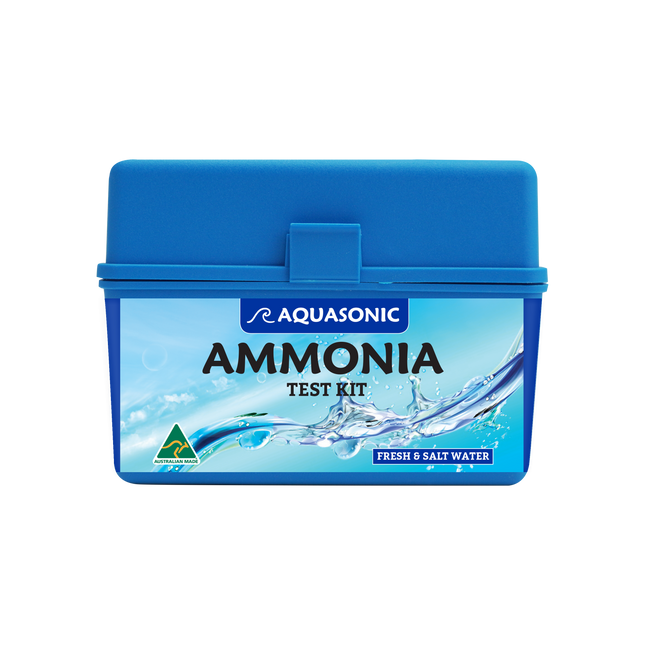
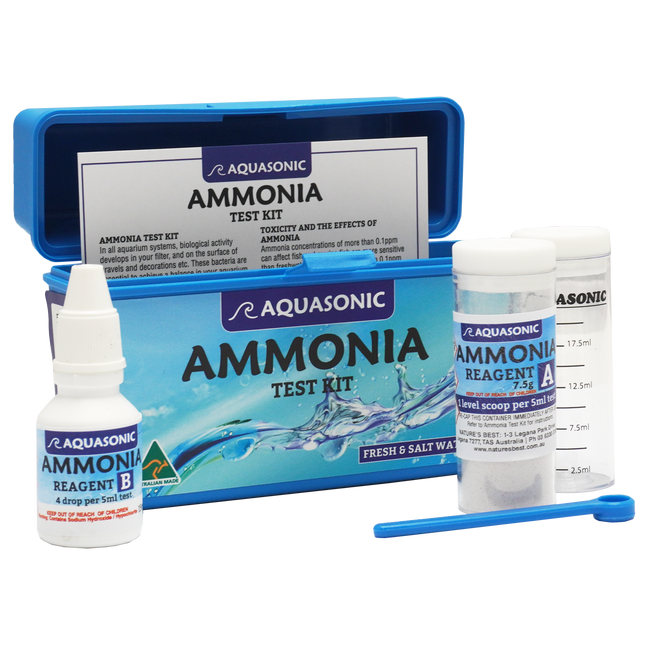
Aquasonic Aquasonic - Ammonia Test Kit
In all aquarium systems, biological activity develops in your filter, and on the surface of gravels and decorations etc. These bacteria are essential to achieve a balance in your aquarium and different types of bacteria need to be present in the right proportions to break down waste and deal with ammonia, nitrite and nitrate, which can all be harmful to your fish. Every time you change or add something in your tank, or you clean it, you potentially upset the balance because you are effectively removing some of these bacteria. Derivation of Ammonia Ammonia occurs in water from two commons origins: The decomposition of fish waste, decaying food and dead fish. Many water supplies now contain chloramines. The addition of some water purifiers to tap water containing chloramines releases the chlorine and leaves ammonia. Toxicity and the Effects of Ammonia Ammonia concentrations of more than 0.1ppm can affect fish and marine fish are more sensitive than freshwater fish. Levels of less than 0.1ppm as a rule are harmless. However, when levels occur at 1ppm or greater, immediate action should be taken to alleviate the problem. Dealing with Ammonia Ammonia that occurs as a result of fish waste is best dealt with on a constant basis by biological filtration, which, once established in an aquarium, will convert the ammonia to nitrate. Remove any uneaten food or dead fish before decomposition to minimise the source of ammonia. Ammonia may be neutralised in aquaria or shipment water by using Aquasonic Ammo-gone. Chloramines in tap water may be neutralised by Aquasonic Ammo-gone or Aquasonic Power Water Conditioner. In situations where there is a high number of fish and little or no filtration, e.g., fish holding ponds or shipment bags, some relief can be obtained with pH control. In such situations for freshwater, keep the pH below 7.0 and in saltwater 7.3. Water Quality Ammonia creates stress and can cause fish deaths by lowering fish resistance to disease. Diligent testing of your water for ammonia is the best defence for the health of your fish. To Break the Ammonia - Nitrite - Nitrate Cycle Perform a water change. Remove anything that can cause ammonia to form (e.g. dead organic matter or excess fish waste) from amongst the substrate (e.g. gravel cleaner). Use Aquasonic Ammo-gone to neutralise ammonia in the system. The manual addition of live strains of nitrifying bacteria can also aid in kick starting the biological activity in the filter system.
$34.59 $27.00
-
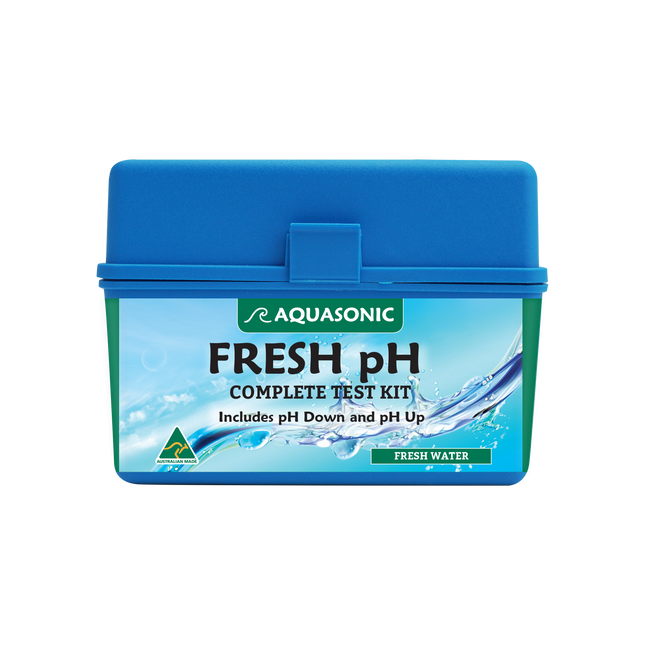
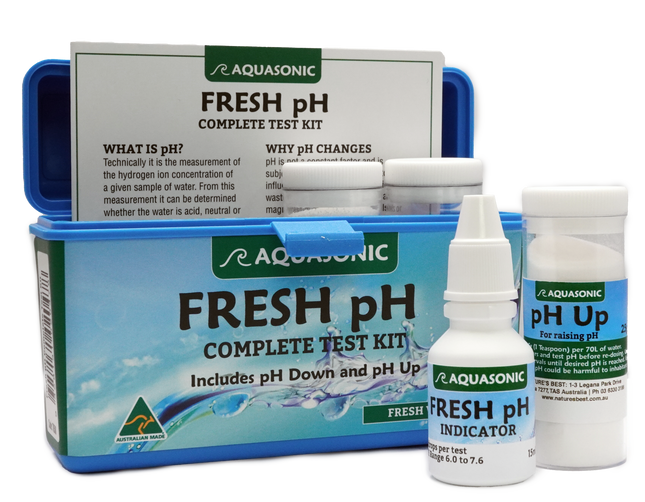
Aquasonic Aquasonic - Complete Freshwater pH Test Kit
Products For pH Adjustment pH Down (contained in this kit) Use 5g (1 teaspoon) per 70L of water. Wait 12 hours and test pH before redosing. Re-dose at 12 hour intervals until desired pH is reached. pH Up (contained in this kit) Use 5g (1 teaspoon) per 70L of water. Wait 12 hours and test pH before re-dosing. Re-dose at 12 hour intervals until desired pH is reached. Directions for Use Rinse a clean test tube and cap several times in water to be tested. Fill to line (12.5ml) with water to be tested. Add 3 drops of Indicator solution Place the test tube on the white background of the colour chart, view vertically (down inside the test tube) with the light behind you. The colour in the test tube is best viewed with natural light. View immediately. Note: Adjust pH slowly.
$31.09 $24.00
-
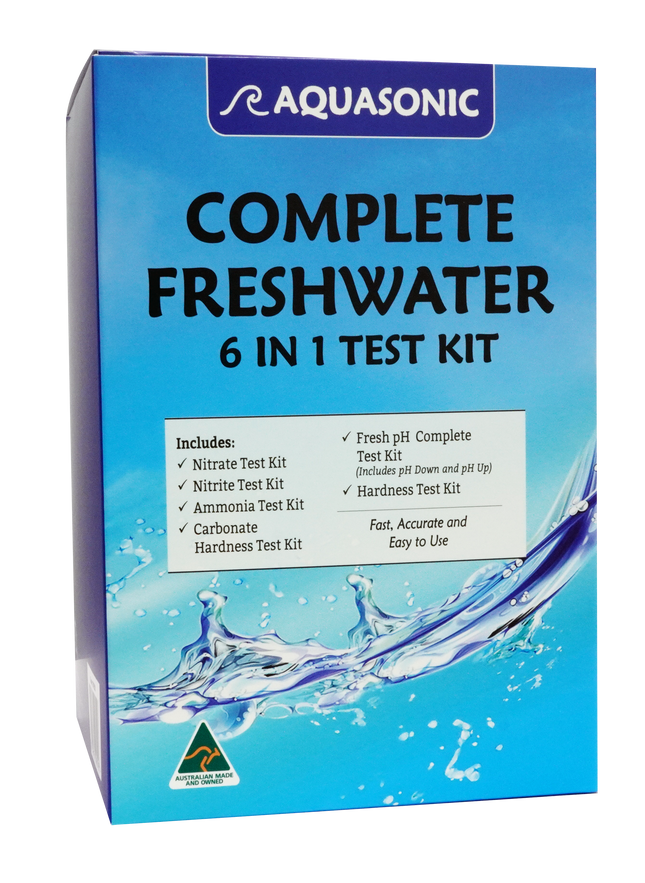

Aquasonic Aquasonic - Complete Freshwater 6 in 1 Test Kit
The Aquasonic Complete Freshwater 6 in 1 Test Kit is all you need to ensure you have the perfect water conditions in your aquarium. This 6 in 1 Test Kit includes: Nitrate Test Kit Nitrite Test Kit Ammonia Test Kit Carbonate Harness Test Kit Fresh pH Compele Test Kit (includes pH Down and pH Up) General Hardness Test Kit Each test kit includes an information card, colour chart, and a clear measuring vial. Fast, accurate and easy to use!
$152.09 $117.00
-
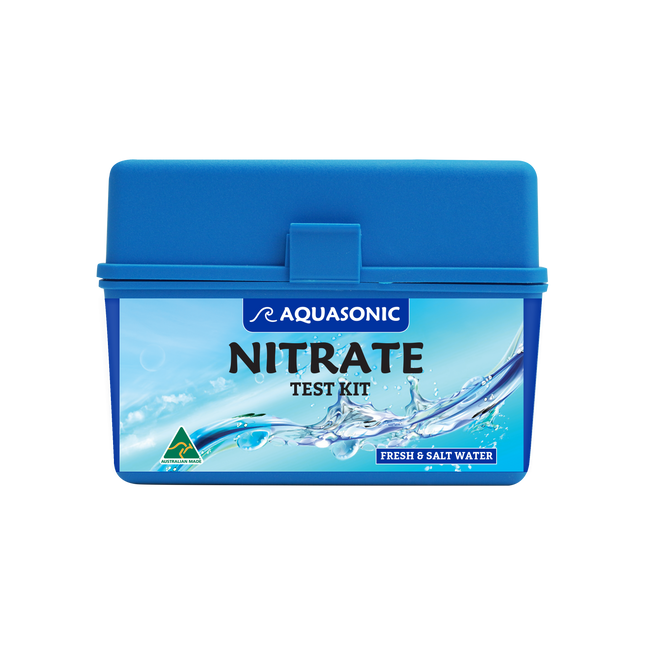
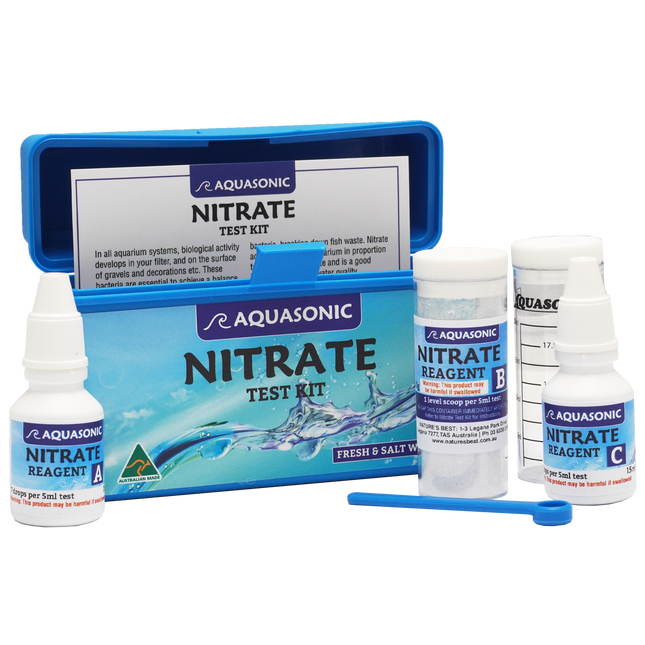
Aquasonic Aquasonic - Nitrate Test Kit
In all aquarium systems, biological activity develops in your filter, and on the surface of gravels and decorations etc. These bacteria are essential to achieve a balance in your aquarium and different types of bacteria need to be present in the right proportions to break down waste and deal with ammonia, nitrite and nitrate, which can all be harmful to your fish. Every time you change or add something in your tank, or you clean it, you potentially upset the balance because you are effectively removing some of this bacteria. Nitrate Nitrate ions are produced as a result of biological action occurring mainly in your aquarium filter system. It is the residue of a chain reaction by aerobic bacteria, breaking down fish waste. Nitrate accumulates in an aquarium in proportion to the stock load waste and is a good indicator of general water quality. Permissible Nitrate Levels As nitrate levels increase, water quality decreases. The quantity of permissible nitrate varies with the particular aquatic life being cultured. a) For marine systems culturing fish, acceptable levels are 20ppm to 40ppm. Many species of marine fish will accept higher levels of 80ppm to 100ppm without apparent effect on their health. But it is recommended that when levels climb above 40ppm steps should be taken to lower the nitrate to avoid stress. b) For reef systems culturing invertebrates, much lower levels of nitrate are acceptable. A level of 5ppm or less is optimum. Again, many invertebrates will accept higher levels but once these levels climb above 20ppm many of the more sensitive invertebrates will be irreparably damaged. It has been shown that small quantities of around 5ppm of nitrate are of assistance in culturing marine plants. Nitrate tests on reef systems should occur weekly and levels should be kept below 10ppm. c) Freshwater fish. Tolerance to nitrate with freshwater fish is higher than saltwater species. Some delicate species will tolerate around 50ppm, but some species will tolerate far higher levels. It is recommended that as nitrate levels approach 50ppm steps should be taken to reduce the level. Lowering Nitrate The easiest method to lower nitrate is to change water. Regular water changes should ensure that the nitrate levels stay within acceptable limits. Recommended minimum water change requirements are 25% per month. If water changes do not keep the nitrate at acceptable levels, then perhaps the number of fish in the tank is too great for your aquarium system, so reduce the number of fish. Denitrification filters can lower nitrate successfully, but this must be closely monitored to avoid dangerous gases that can harm aquarium inhabitants. Marine plants and algae can use some nitrate as nutrients and are a definite advantage in the control of nitrate. To Break The Ammonia - Nitrite - Nitrate Cycle: Perform a water change Remove anything that can cause ammonia to form (e.g., dead organic matter or excess fish waste) from amongst the substrate (e.g., gravel cleaner) Use Aquasonic AMMO-GONE to neutralise ammonia in the system. The manual addition of live strains of nitrifying bacteria can also aid in kick starting the biological activity in the filter system. Directions for Use to Determine the Nitrate Level in Water: Rinse empty test tube and cap several times in the water to be tested. Fill the test tube to the 5ml mark and add 7 drops of Reagent A. Swirl to mix. Add 1 level scoop of Reagent B and gently swirl the solution for a few seconds. Ensure that Reagent B is kept dry at all times. Add 7 drops of Reagent C, mix for a few seconds and let the solution stand for 3 minutes after which time full colour development will have occurred. Place the test tube on the white background of the colour chart, view vertically down the tube. The colour in the test tube is best viewed with natural light behind you. On completion of the test, rinse clean the test tube. Ensure Reagent B remains dry and that the cap is firmly in place. Note: If the nitrate level in the test solution is more than 80ppm (use your colour chart to determine) then you can still determine the level by diluting the sample with nitrate free water (preferably distilled water). For example, to prepare a test that will measure up to 160ppm nitrate, mix a sample with half water to be tested and half water that is nitrate free. Then multiply the results of the test by 2. To read up to 320ppm nitrate, use 25% water to be tested and 75% nitrate free water, then multiply the result by 4. *Colour chart to be used as a base guide only. Colours may vary according to various water conditions.
$39.79 $31.00
-
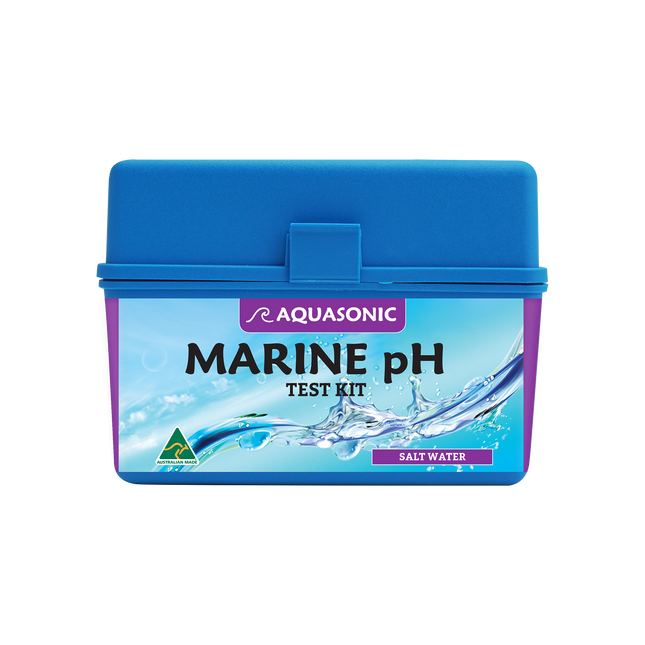
Aquasonic Aquasonic - Marine pH Test Kit
Normal pH The pH of water in the ocean is around 8.1. This is also the recommended pH of a marine aquarium, with levels slightly above or below this value considered acceptable. This happens as a result of the carbonate hardness value of sea water, which is about 125ppm. However, certain events such as biological filtration of a marine aquarium, tend to reduce the carbonate hardness value and therefore lower the pH. Also certain influences, such as carbon dioxide, can affect the reading of pH value. Biological Filtration The assimilation of waste by bacteria in the filter of a marine aquarium is an acidifying process and in time will reduce the carbonate hardness value of the water. As this occurs, the pH value will fall. Carbonate hardness levels can be maintained with Aquasonic Carbonate Hardness Generator Powder. At a pH of 8.1 the carbonate hardness value should be 125ppm. If the carbonate hardness value of a marine aquarium is correct, yet pH values are not, the influence of carbon dioxide should be considered. The Effects of CO2 For pH to read correctly, carbon dioxide must be in equilibrium with the atmosphere. Carbon dioxide is produced by fish, plants, corals and bacteria assimilating waste in the biological filter in the aquarium. Some trickle (mini-reef) filters can expel carbon dioxide so efficiently that the quantity of carbon dioxide is less than the atmosphere, so pH reads higher than it really is. Likewise, in an aquarium with substrate filtration, carbon dioxide has some difficulty escaping as it is produced by the biological filter and other life. Under these conditions, carbonic acid may be formed and pH will read lower. Using pH to Advantage During the development of bacteria in a biological filter, ammonia and nitrate conditions ensure. Both are deadly to marine fish. The toxicity of ammonia and nitrite, however, is in direct relation to the pH value of the water in the system. By lowering the pH, the toxicity of these deadly conditions is minimised. To lessen the toxicity of nitrite, lower the pH to 7.5.
$26.49
-
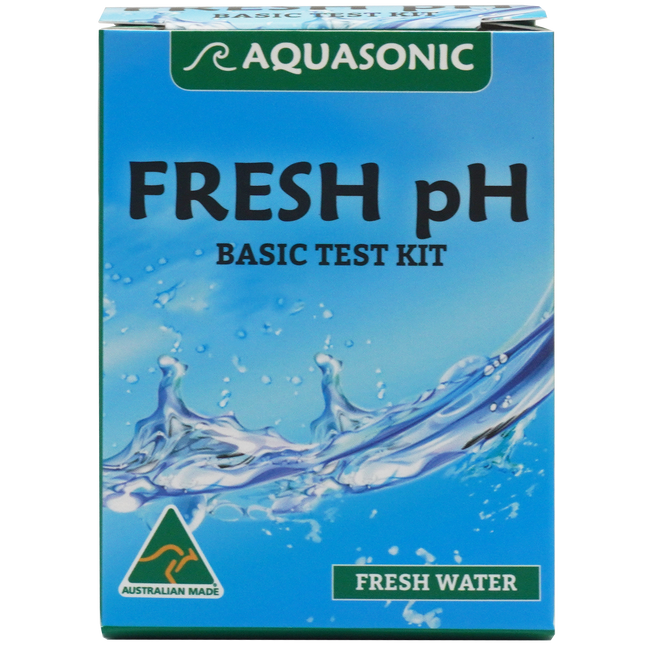

Aquasonic Aquasonic - Basic Freshwater pH Test Kit
What is pH? Technically it is the measurement of the hydrogen ion concentration of a given sample of water. From this measurement it can be determined whether the water is acid, neutral or alkaline. The scale extends from 0 to 14. A pH between 0 and 7 is termed acid, and a pH between 7 and 14 is termed alkaline. The indicator in this kit has a pH range from 6.0 to 7.8 and is therefore suitable for most freshwater aquaria. At or below pH 6.0 the test sample would turn yellow. At or above pH 7.8 the test sample would turn blue. Why pH Changes pH is not a constant factor and is subject to continual change due to influences like bacterial assimilation of waste causing acidity or calcium and magnesium compounds like shells or coral that cause alkalinity. Thus, under normal aquarium conditions, because of fish waste and unused food, the water would drift to acidity. Directions for Use: Rinse a clean test tube and cap several times in water to be tested. Fill to line (12.5ml) with water to be tested. Add 3 drops of Indicator solution Place the test tube on the white background of the colour chart, view vertically (down inside the test tube) with the light behind you. The colour in the test tube is best viewed with natural light. View immediately. Adjust pH slowly.
$17.59
-
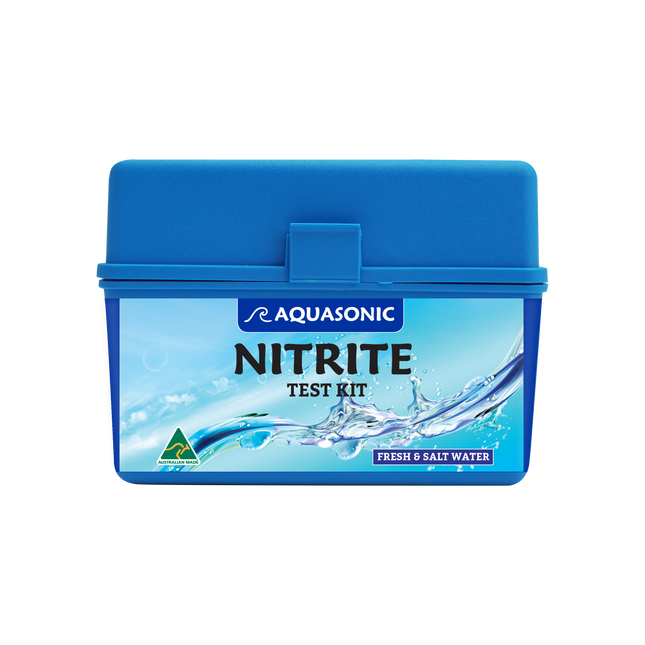
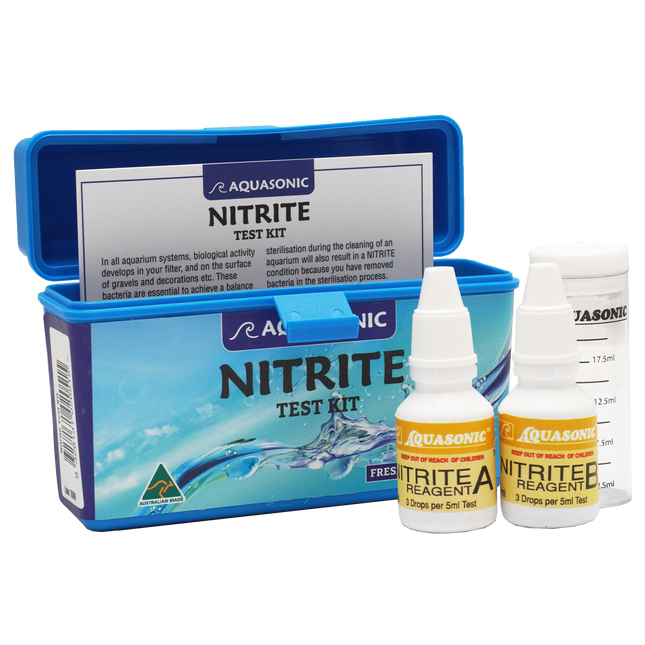
Aquasonic Aquasonic - Nitrite Test Kit
In all aquarium systems, biological activity develops in your filter, and on the surface of gravels and decorations etc. These bacteria are essential to achieve a balance in your aquarium and different types of bacteria need to be present in the right proportions to break down waste and deal with ammonia, nitrite and nitrate, which can all be harmful to your fish. Every time you change or add something in your tank, or you clean it, you potentially upset the balance because you are effectively removing some of these bacteria. The replacement of plants and coral or cleaning of filters, gravel or substrate, even in part, can also cause a NITRITE condition to re-occur, even in well-established aquariums. Complete sterilisation during the cleaning of an aquarium will also result in a NITRITE condition because you have removed bacteria in the sterilisation process.NITRITE is toxic to fish, even in quantities as small as 1ppm. If you are starting a new aquarium, it is recommended that you don’t put new fish into the system until a NITRITE reading of less than 1ppm is achieved (ideally zero). Recurring Nitrite Condition The biological activity in a filter may take as long as three months to develop fully, and in this time, due to increases in the number of fish, the NITRITE condition may re-occur. Evidence has shown, by lowering the pH to 7.5, the toxicity of NITRITE is minimised. If a system does develop nitrite on a continual basis, after it is fully conditioned, it may mean that the surface area of the biological filter is undersized, or the number of fish in the tank is too great. Assisting Biological Establishment To assist, ensure the temperature is steady, at or above 26 deg C, check the flow of water through the filters is well distributed and sufficient, and oxygen levels are adequate. When cleaning your filter media, use cold or lukewarm water only as hot water will kill the bacteria. To Break The Ammonia - Nitrite - Nitrate Cycle: Perform a water change Remove anything that can cause ammonia to form (e.g., dead organic matter or excess fish waste) from amongst the substrate (e.g., gravel cleaner) Use Aquasonic AMMO-GONE to neutralise ammonia in the system. The manual addition of live strains of nitrifying bacteria can also aid in kick starting the biological activity in the filter system. Directions for Use: Rinse the clean test tube and cap several times in the water to be tested. Fill the test tube to the 5ml mark with the water to be tested. Add 3 drops of Nitrite Reagent A. Add 3 drops of Nitrite Reagent B. Cap the test tube and invert twice. Wait a minimum of 2 minutes, but no longer than 3 minutes, to compare the test with the colour chart. After this time the test will continue to colour, but further colouration is irrelevant. Place the test tube on the white background of the colour chart and view vertically down the tube. The colour in the test tube is best viewed with natural light behind you. After completion of the test, wash the test tube carefully as a previous test could influence the next one.
$33.49 $26.00
-
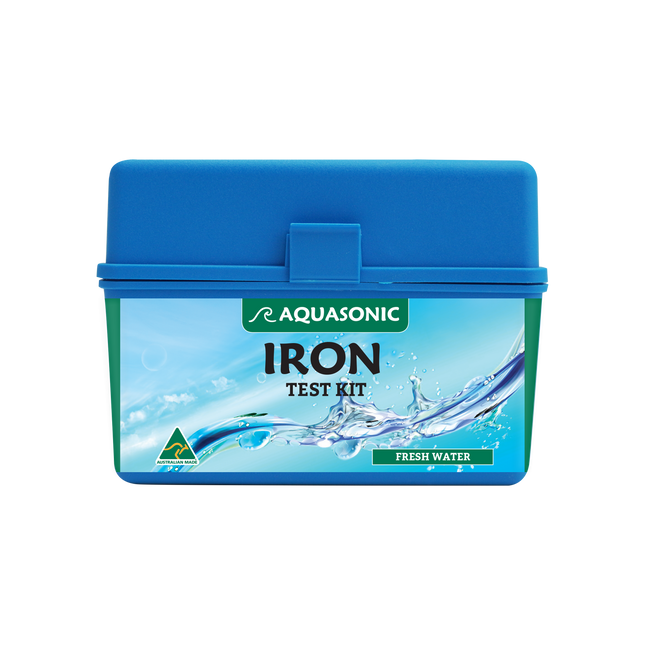
Aquasonic Aquasonic - Iron Test Kit
Growing Aquatic Plants In the natural state some river systems plants grow particularly well. These are the ones with certain water qualities and constant supplies of nutrients. Water that comes from limestone areas or springs (usually containing high levels of carbonates and/or carbon dioxide) support high levels of growth and plant varieties. Ponds or billabongs that contain rich sediment also support certain aquatic plants, growing in and out of water. The river systems however, that support the type of plants most suited to aquarium application are the ones with sustained levels of inorganic nutrients, one of the most important being iron. Plant Nutrients in the Aquarium Iron is considered the most important nutrient for aquatic plants. Recommended levels vary between 0.25 and 1.0ppm. Total levels of 2.0ppm may be harmful to both fish and plants. Aquatic plants can only use inorganic nutrients while they exist in a non-oxidized form. This fact presents a major problem when feeding aquatic plants ordinary fertilizers, because water and dissolved oxygen will oxidize certain important elements within hours. Furthermore, some of the nutrients supplied in plant foods, chiefly phosphates and nitrates, are unwanted in an aquarium and would most likely result in an algae problem. Aquasonic BASIC-GRO and DAILY-GRO have overcome the oxidization problem by specially formulating nutrients that only plants can use, nutrients made for aquatic application.
$39.79 $31.00
-
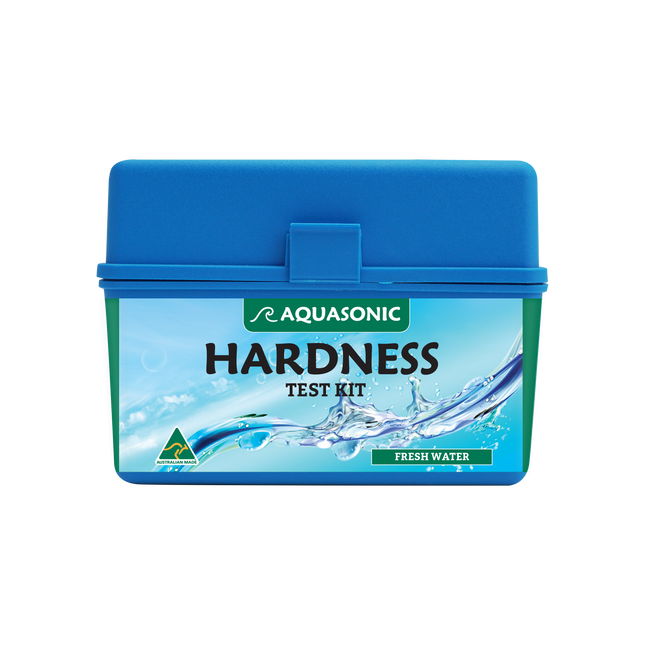
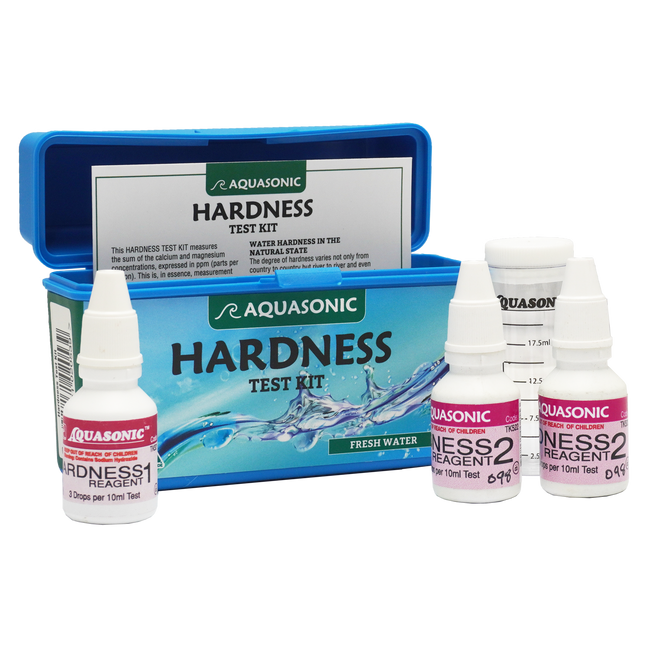
Aquasonic Aquasonic - Hardness GH Test Kit
This HARDNESS TEST KIT measures the sum of the calcium and magnesium concentrations, expressed in ppm (parts per million). This is, in essence, measurement of the permanent hardness of water, but the measurement may also contain some temporary hardness in the form of calcium dissolved by carbon dioxide in water. This form of temporary hardness is usually minimal. How Does Water Become Hard? Water hardness results from dissolved compounds of magnesium and calcium. With temporary hardness, magnesium and calcium are dissolved by carbon dioxidein water. This process can be reversed by removing the carbon dioxide, e.g. By boiling,or as aquatic plants use carbon dioxide. However, if the salts of magnesium or calciumare dissolved as a result of an acid present in water, the hardness becomes permanent. Water Hardness In The Natural State The degree of hardness varies not only from country to country but river to river and even the hardness in each river varies from season to season. Aquatic life have different requirements according to geographical location and though most fish can stand a great deal of variation in hardness, they do best at specific levels. Factors like breeding of a species, the colour of a species or even the inhibition of fungal diseases can be greatly enhanced by the hardness of water. Species Requirements Examples of fish that live at or below 150ppm are Angels, Corydoras, Catfish, Discus, Gouramis, Loaches, South American Tetras. Examples of fish that live between 150ppm and 300ppm are some Australian Natives, Guppies, Sword Tails, Mollies, Platties, and Goldfish. Examples of fish living above 300ppm and usually under 500ppm are African Cichlids, and Brackish water species. Directions for Use: The test kit has a dual range, measurements can be made in steps of 10ppm or 20ppm (ppm = parts per million). Complete the test within 5 minutes. To Test in 10ppm: Rinse a clean test tube several times in the water to be tested and fill to the 10 ml mark. Add 3 drops of Reagent 1, swirl to mix, then add 3 drops Reagent 2 and swirl to mix. Now add Reagent 3 (hold the bottle vertically), a drop at a time, swirl to mix before adding the next drop. Keep count of the drops. When the colour changes from red to blue the end point has been reached. Multiply the number of drops by 10 for the reading in parts per million. To Test in 20ppm: Rinse a clean test tube several times in the water to be tested and fill to the 5ml mark. Add 2 drops of Reagent 1, swirl to mix, then add 2 drops of Reagent 2 and swirl to mix. Now add Reagent 3 (hold the bottle vertically), a drop at a time, swirl to mix before adding the next drop. Keep count of the drops. When the colour changes from red to blue the end point has been reached. Multiply the number of drops by 20 for the reading in parts per million.
$39.79 $31.00
-
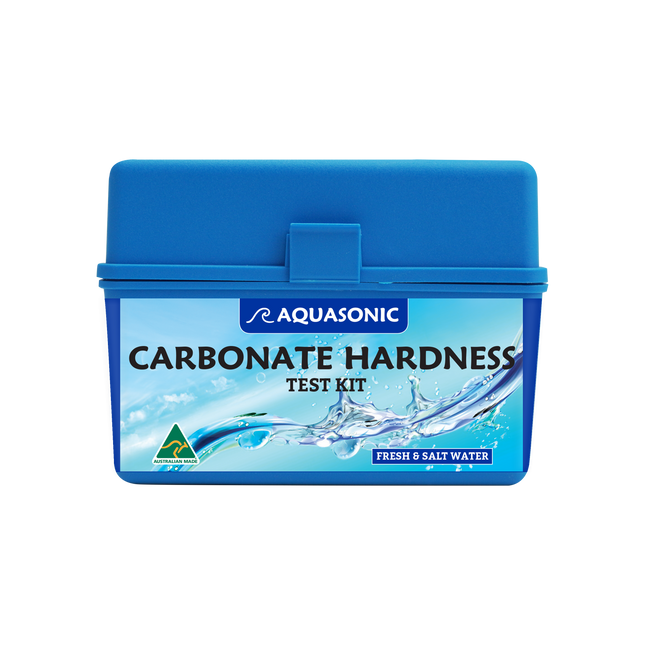
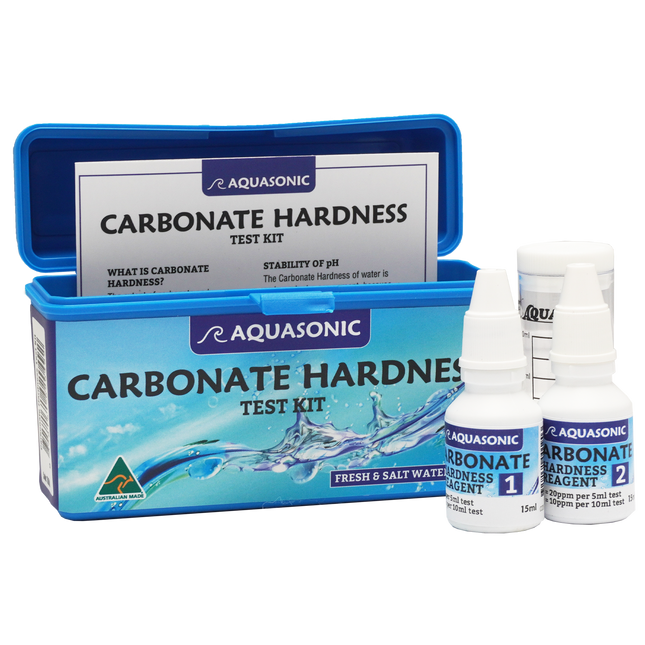
Aquasonic Aquasonic - Carbonate Hardness KH Test Kit
What is Carbonate Hardness? The extent of carbonate and bicarbonate contained in a sample of water is the Carbonate Hardness value of that sample. Carbonate Hardness affects all aquaria, both salt and fresh. It is called many names, according to the jargon of an industry or country of origin of the test kit, eg CARBONATE HARDNESS = ALKALINITY = kH (German) = ACID BINDING CAPACITY. Stability of pH The Carbonate Hardness of water is an important measurement, because the level of Carbonate Hardness is the basis for the value of the pH in a given sample of water. A strong Carbonate Hardness reserve in water can mean a very stable pH and the bonus of an alternative supply of carbon dioxide for plants and algae if supply runs short in an aquarium. This applies equally for marine or freshwater aquaria. Depletion of the Carbonate Hardness Reserve Acids which form as a result of the breakdown of waste products by bacteria (via biological filtration) is the most common way the carbonate hardness reserve is depleted. In aquariums with little or no carbonate hardness the pH is very unstable and can drop very quickly to acid. Raising Carbonate Harness Aquasonic Carbonate Hardness Generator Powder is recommended for fresh or salt water applications. 5g will raise the Carbonate Hardness of 100L of water by 20ppm. Directions for Use: The test kit has a dual range, which measures in steps of 10ppm or 20ppm (ppm = parts per million) To Test in 10ppm: Rinse the clean test tube several times in the water to be tested. Fill the test tube accurately to the 10mL mark. Add 2 drops REAGENT 1 and swirl to mix. A blue colour forms. Now add REAGENT 2 a drop at a time and swirl to mix. Keep count of the drops. As the end point is reached the test tube colour will change to green. Add 1 more drop to complete the change to yellow. Multiply the number of drops by 10 for the reading in ppm. To Test in 20ppm: Rinse the clean test tube several times in the water to be tested. Fill the test tube accurately to the 5mL mark. Add 1 drop of REAGENT 1 and swirl to mix. A blue colour forms. Add REAGENT 2 a drop at a time and swirl to mix. Keep count of the drops. When the colour changes to yellow the end point is reached. Multiply the number of drops by 20 for a reading in ppm. Note: Place the test tube on the white background of the colour chart with the light behind you. The colour in the test tube is best viewed with the natural light.
$31.09 $24.00
-
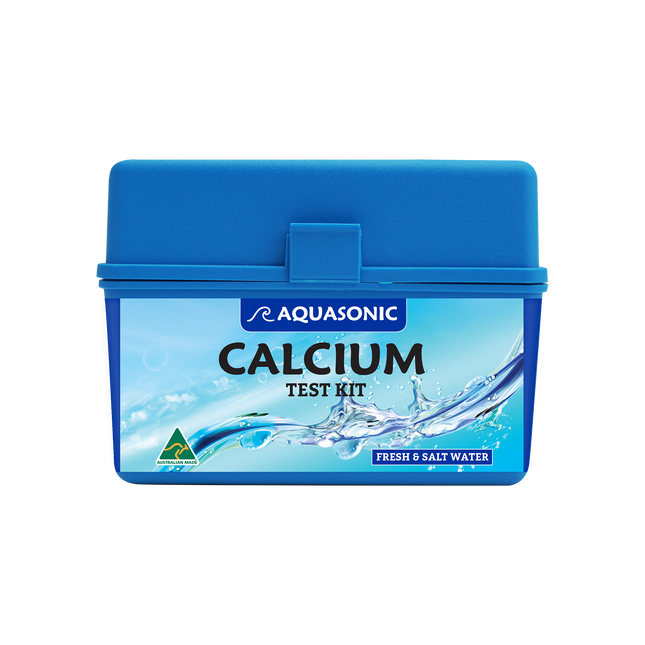
Aquasonic Aquasonic - Calcium Test Kit
What is Calcium? Calcium, scientific formula as Ca, is a very important element for most animal life, especially for corals and shellfish. It is the main cause of hard freshwater. Certain species of freshwater fish require certain levels of calcium. It is also the main ingredient in limestone, shellgrit and coral. Calcium, as an element, does not affect pH. Normal Levels In seawater the level of calcium at normal specific gravity is 383ppm. If seawater is used at a lower specific gravity than normal, levels of calcium will be proportionally less. For freshwater aquariums please check appropriate text books, however all Aquasonic Water Conditioners have exacting amounts of calcium to suit designated species. Calcium Build Up It is most important in both fresh and saltwater aquaria to set the levels of calcium when establishing the aquarium and then hold the appropriate levels by the addition, if necessary, of calcium in prescribed amounts. The use of shellgrit or coral rubble as a substrate or filter material can cause calcium levels to continually rise, to unacceptable levels. Reef Aquariums A maximum level of 450ppm is recommended for Reef Aquariums. If the level is taken above this then Carbonate Hardness levels, the main reason for stable pH, may be affected. The calcium would precipitate the carbonate as calcium carbonate. Calcium is used by calcareous algae, corals and shellfish, so in some situations, levels may require constant replenishment. To Set Calcium Levels In salt water, maintain levels with Aquasonic Ocean Nature Sea Salt. Normal specific gravity = 383ppm. Raise calcium in saltwater with Aquasonic Calcium-Sup. In freshwater, maintain levels with Aquasonic Water Conditioning Salts. Directions for Use: To determine Calcium in Salt or Fresh Water. Read Instructions Carefully Before Use. The test kit has a dual range. Measurements can be made in steps of 25ppm or 50ppm. Note: Seawater usually contains 350-450ppm of calcium. To Test in 25ppm: Rinse a clean test tube several times in the water to be tested and fill to the 10ml mark. Add 1 level scoop of Reagent A and 4 drops of Reagent B. Shake until powder dissolves (about 1-2 minutes). Solution will turn bright red if calcium is present. Immediately add Reagent C a drop at a time, swirling to mix after each addition. Keep count of the number of drops until colour changes to the end point (see chart) and multiply this by 25 to give calcium in ppm. To Test in 50ppm: Rinse a clean test tube several times in the water to be tested and fill to the 5ml mark. Add 1/2 scoop of Reagent A and 2 drops of Reagent B. Shake until powder dissolves (about 1 minute). Solution will turn bright red if calcium is present. Immediately add Reagent C a drop at a time, swirling to mix after each addition. Keep count of the number of drops until colour changes to the end point (see chart) and multiply by 50 to give calcium in ppm. *This colour chart provides a basic guide only. Colours may vary according to various water conditions.
$39.79 $31.00
-

Aquasonic Aquasonic - Phosphate Test Kit
About Phosphates There are two types, Organic and Inorganic. The type we test for in aquaria is the Inorganic type, PO4. All living matter contains phosphorus but unfortunately organic phosphate can only be tested for in laboratories using sophisticated testing equipment. The Effect of Phosphates In reef aquariums, levels of phosphates above 0.5ppm can adversely affect the growth of both hard and soft corals. It is recommended to keep phosphates at a maximum of 0.25ppm. In both fresh and saltwater aquariums phosphates above 0.5ppm can cause the growth of hair algae, blue green algae and other types of algae, including green water in ponds and lakes. A side affect of phosphate in saltwater aquarium, is the precipitation of calcium. There is no evidence that levels of phosphates affect the health of fish. High levels, say above 20ppm, may affect growth. Where Phosphate Comes From The sources can be many and varied. Some tap water contains phosphates originating from agricultural run off or added by municipal water authorities to reduce levels of heavy metals. Some phosphates are a bi-product of fish waste or decaying algae. Some aquarium products e.g., pH adjusters, contain some phosphates. Most phosphate, however, comes from uneaten fish food due to over-feeding. How to Reduce Phosphates The two considerations are: A) to reduce the level already present in the aquarium, use a Phosphate Sponge or similar. B) by changing some water in the aquarium. Take steps to stop the build up in the first place. If the tap water contains phosphates, filter before use with a Phosphate Sponge or use RO water. Do not over feed. Most important in controlling phosphates in any situation is to reduce the levels of waste or debris that may be present in the aquarium gravel or in silt behind rocks, coral etc. Change pre-filter or mechanical filters on a weekly or more frequent basis. How to Determine Phosphate (as Inorganic Orthophosphate) in Salt or Fresh Water Rinse the clean test tube several times in the water to be tested. Fill the test tube to the 20ml mark with sample to be tested. Add 4 drops of Reagent A. If solution turns red, add Reagent B dropwise until colour disappears. If there is no colour evident after adding Reagent A go to step 4. Add 4 drops of Reagent B and mix. Add 2 drops of Reagent C and mix immediately. Wait one minute but no longer than five minutes after the addition of Reagent C to measure the colour intensity of the sample against the colour chart. Place the test tube on the white background of the colour chart, view vertically with the light behind you. The colour in the test tube is best viewed with natural light. Note Be sure to cap all reagent bottles tightly. Reagent B is highly acidic and will cause skin irritation. If skin contact does occur wash immediately with cold water. After completion of the test, wash the test tube thoroughly as a previous test could influence the next one.
$46.29 $36.00




















